Attached files
| file | filename |
|---|---|
| 8-K - FORM 8K - PDS Biotechnology Corp | s001995x1_8k.htm |
Exhibit 99.1

December 2017(Nasdaq: EDGE) ®

Disclaimer This presentation and any statements of representatives of Edge related thereto that are not historical in nature (including but not limited to upcoming milestones) contain, or may contain, among other things, certain "forward-looking statements" within the meaning of the Private Securities Litigation Reform Act of 1995. These forward-looking statements may include, without limitation, statements with respect to Edge's plans, objectives, projections, expectations and intentions and other statements identified by words such as "projects," "may," "will," "could," "would," "should," "believes," "expects," "anticipates," "estimates," "intends," "plans," "potential" or similar expressions. These statements are based upon the current beliefs and expectations of Edge's management and are subject to significant risks and uncertainties. Actual results may differ significantly from those set forth in the forward-looking statements. These forward-looking statements involve certain risks and uncertainties that are subject to change based on various risk factors (many of which are beyond Edge's control) as described under the heading "Risk Factors" in Edge's filings with the United States Securities and Exchange Commission. 2

EDGE Therapeutics® Overview 3
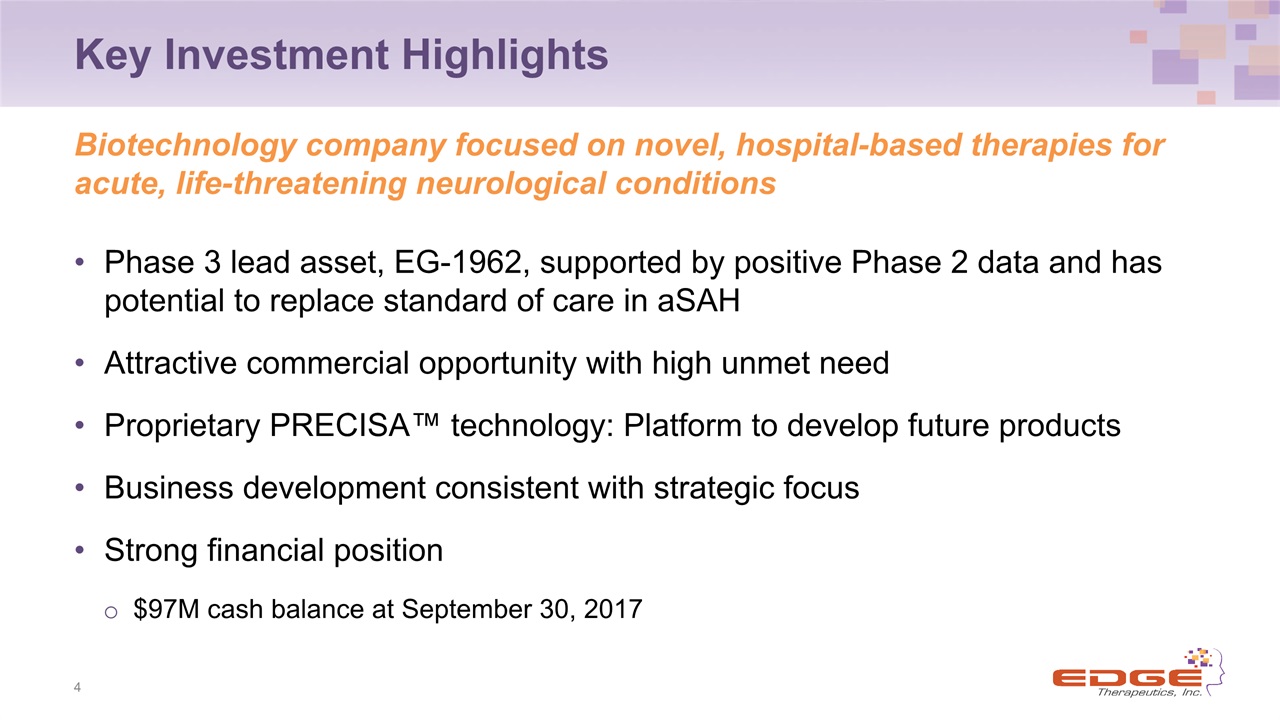
Key Investment Highlights Phase 3 lead asset, EG-1962, supported by positive Phase 2 data and has potential to replace standard of care in aSAHAttractive commercial opportunity with high unmet needProprietary PRECISA™ technology: Platform to develop future productsBusiness development consistent with strategic focusStrong financial position$97M cash balance at September 30, 2017 4 Biotechnology company focused on novel, hospital-based therapies for acute, life-threatening neurological conditions

Product Development Pipeline 5

Near-term Catalysts Data readout from EG-1962 phase 3 NEWTON 2 pivotal studyTop-line data from full study in late-2018Futility analysis by end-2017Interim analysis in early-2018Submit investigational new drug (IND) application for second PRECISA product in 2018 6

Aneurysmal Subarachnoid Hemorrhage (aSAH) Ruptured brain aneurysm: bleeding into the subarachnoid space in the brainPatient Demographics85-90% of patients make it alive to the hospital83% of poorer grade patients die or suffer permanent brain damage within 90 days*Delayed complications occur in up to 30% of patients who survive initial hemorrhage 7 SAH Patients Annually EG-1962 Market Expansion StrategyAlternative Delivery(Cisternal, Lumbar, EVD)~50% EG-1962 Initial Market IndicationExternal Ventricular Drain (EVD)~50% Addressable U.S. Population35,000 SAH patients Hospital AdmissionAneurysm Repair (endovascular or surgery) * Hänggi D, Etminan N, Macdonald RL, Steiger, HJ. NEWTON - Nimodipine microparticles to Enhance recovery While reducing TOxicity after subarachNoid hemorrhage. Neurocritical Care. Published Online: 13 February 2015. 600,000 Worldwide 100,000 North America, EU, Japan

Current Management of aSAH 8 Aneurysm RuptureExternal Ventricular Drain (EVD) ~50% of patients Universal administration of oral nimodipine (Class 1, Level A) Surgical / Endovascular Aneurysm Repair ICU Management(Watch & Wait) * Hänggi D, Etminan N, Macdonald RL, Steiger, HJ. NEWTON - Nimodipine microparticles to Enhance recovery While reducing TOxicity after subarachNoid hemorrhage. Neurocritical Care. Published Online: 13 February 2015. Stabilize Secure Prevent Nimodipine Approved in 1989Reduce delayed ischemia / improve outcome within 96 hours of aSAHStandard of care >60 countries Treats multiple deleterious effects of calcium influx after aSAH Potent and unique dihydropyridine L-type Ca channel antagonist Only 17% of poorer grade patients return to favorable or normal status* - sub-optimal nimodipine in the brainTreatment limiting side effects; systemic hypotension in up to 50% Short half life (45-minutes); requires heavy nursing burden; 2 pills every 4 hours x 21 days + + + + – – –

EG-1962 Differentiation and Existing Data 9

EG-1962 Value Hypothesis Non-clinical studies and our Phase 2 NEWTON study support the proposition that EG-1962:Delivers 100 to 1,000 times the concentration of nimodipine directly to the brain with sustained delivery over 21 days vs. current standard of care oral nimodipineHas the potential to fundamentally transform the management of aSAH and dramatically improve patient outcomes in this vulnerable patient populationVirtually impossible to get similar EG-1962 type concentrations of nimodipine into the brain with oral nimodipine without causing dose-limiting, potentially life-threatening hypotension 10 Higher concentrations of nimodipine administered into the cerebrospinal fluid in the brain would provide superior efficacy compared to systemic administration of oral nimodipine

EG-1962 Differentiation:Targeted Delivery of Nimodipine Directly into the Brain 11 Nimodipine PLGA EG-1962 Efficacy & Safety Nimodipine:dihydropyridine L-type Ca channel antagonist EG-1962: Targeted delivery achieves high brain concentration; yet safe plasma concentrationsDual mode of action from intravascular space and extravascular targetsOne-time administration provides sustained exposure over 21 days; compliance benefit EG-1962 Site-Specific Administration + + +
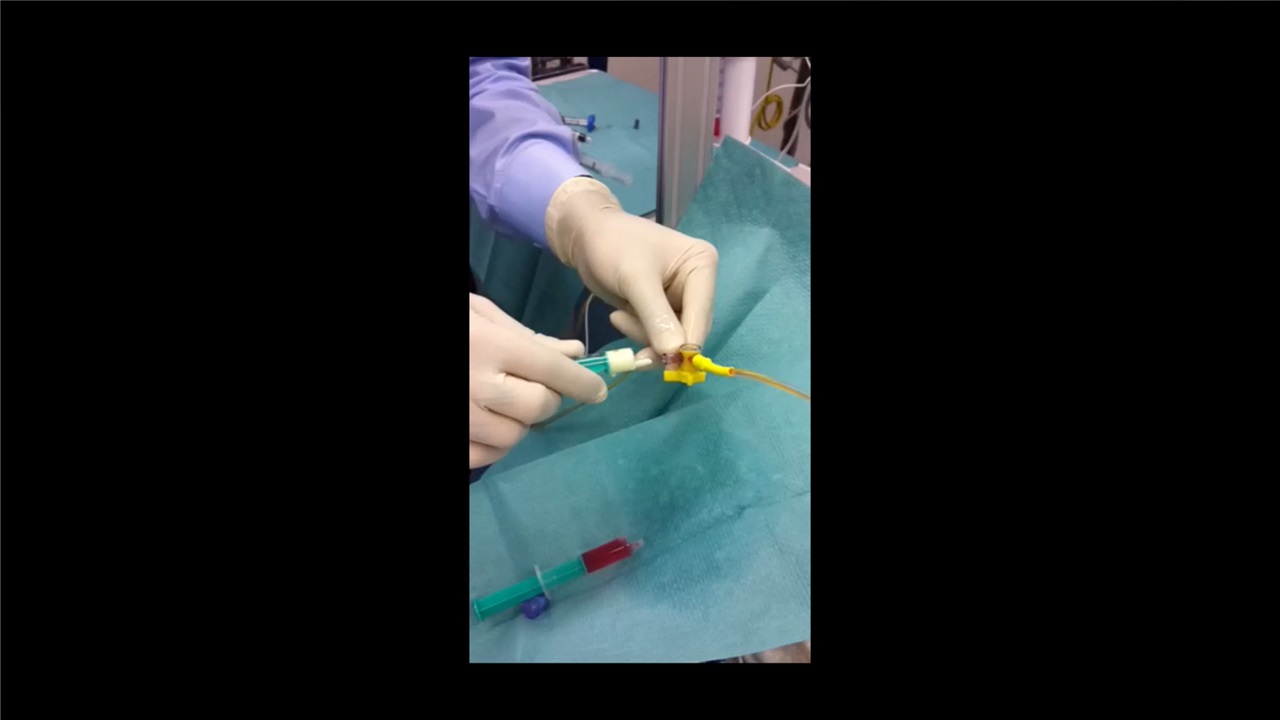
12

EG-1962 achieved steady state sustained release of nimodipine, and 100x-1,000x higher nimodipine concentrations in CSF vs. oral nimodipine Pharmacokinetic Data Supports Clinical Benefit of EG-1962

Steady-state plasma concentration measured in EG-1962-treated patients was below 30 ng/ml, the level observed to cause systemic hypotension 16.7% Nimodipine EG-1962 Did Not Increase Risk of Hypotension

Exploratory endpoints all favorable towards EG-1962 NEWTON Study – Key Highlights 73 patients completed (6 cohorts); 55 EG-1962, 18 oral nimodipineMaximum feasible dose identified (primary endpoint)800 mg All patients tolerated administration Safety & tolerability established (primary endpoint)PK characterized up to 800 mg dose (secondary endpoint) 15 Phase 1/2, international, multi-center, randomized, controlled, open-label study

Dead Vegetative State Lower Severe Disability Upper Severe Disability Lower Moderate Disability 1 2 3 4 5 Unfavorable Outcome EG-1962 Clinical Effect: Over 2x Improvement in Favorable Outcomes in NEWTON Study 16 * Glasgow Outcome Scale (GOSE) Upper Moderate Disability Lower Good Recovery Upper Good Recovery 6 7 Favorable Outcome Oral nimodipine(n=18) EG-1962 Active Control Cohorts 1-5(n=46) 28% HistoricalData Favorable Outcome 59% >2x 8 17% * Hänggi D, Etminan N, Macdonald RL, Steiger, HJ. NEWTON - Nimodipine microparticles to Enhance recovery While reducing TOxicity after subarachNoid hemorrhage. Neurocritical Care. Published Online: 13 February 2015.

GOSE 8 EG-1962 Clinical Effect: ~5x Improvement in GOSE 8 Outcomes in NEWTON Study 17 * Glasgow Outcome Scale (GOSE) Upper Moderate Disability Lower Good Recovery Upper Good Recovery 6 7 Favorable Outcome Oral nimodipine(n=18) EG-1962 Active Control Cohorts 1-5(n=46) 28% HistoricalData Dead Vegetative State Lower Severe Disability Upper Severe Disability Lower Moderate Disability 1 2 3 4 5 Unfavorable Outcome 28% 6% ~5x 8 <1% * Hänggi D, Etminan N, Macdonald RL, Steiger, HJ. NEWTON - Nimodipine microparticles to Enhance recovery While reducing TOxicity after subarachNoid hemorrhage. Neurocritical Care. Published Online: 13 February 2015.
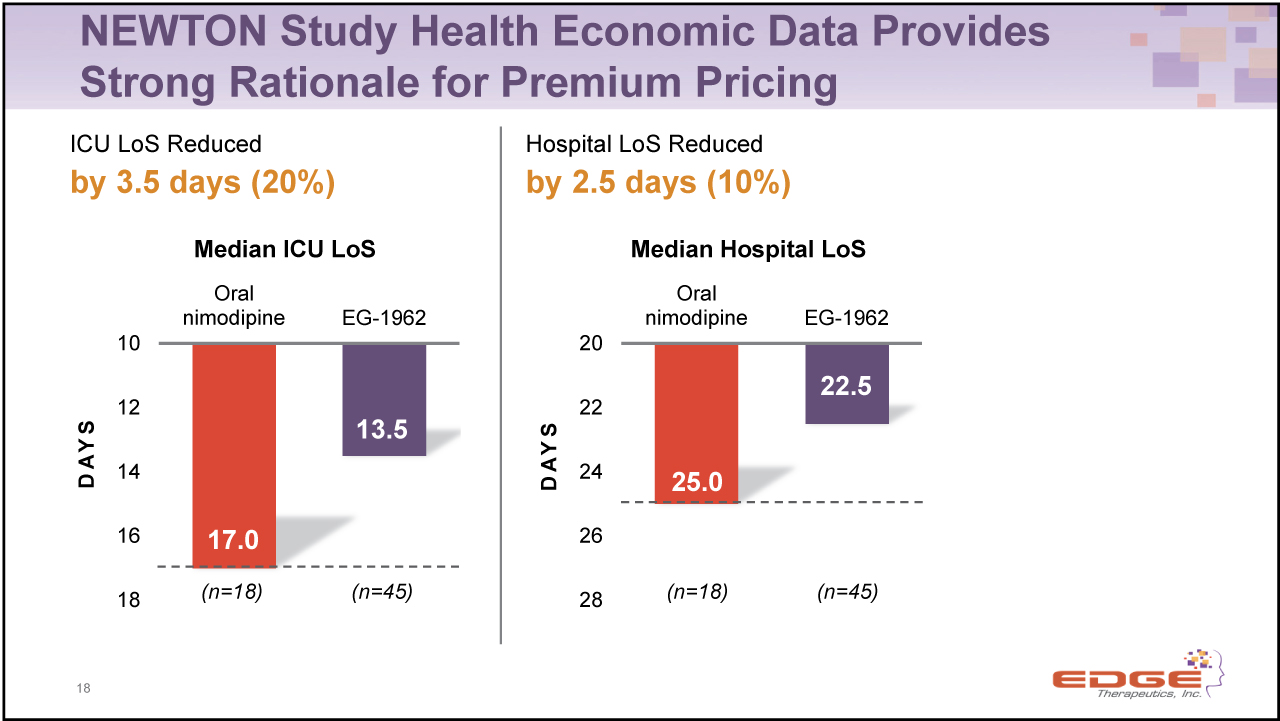
NEWTON Study Health Economic Data Provides Strong Rationale for Premium Pricing 18 ICU LoS Reducedby 3.5 days (20%) Hospital LoS Reducedby 2.5 days (10%) Median ICU LoS Median Hospital LoS (n=45) (n=45) (n=18) (n=18) 13.5 17.0 22.5 25.0

NEWTON Study Reduced Cost Drivers for aSAH Patients; Additional Rationale for Premium Pricing 19 Vasospasm Reduced by 52% EG-1962(n=45) Oral nimodipine(n=18) (n=13/45) (n=11/18) Rescue Therapy Reduced by 57% (n=11/45) (n=10/18) DCI Reduced by 61% (n=6/45) (n=6/18)

NEWTON 2 Phase 3 Pivotal Study Overview 20 ~75 centers (North America, EU, Australasia)1 to 1 randomization; double-blind/double-dummyStratified by WFNS, Age, Region Primary Endpoints Secondary & Health Economic Endpoints Study Sample Size(n = 374) Neurological outcome measured at 90 days after aSAH using GOSESafety profile of EG-1962 compared to oral nimodipine Cognitive assessment using the Montreal Cognitive Assessment (MoCA)ICU and hospital length of stay; discharge dispositionUse of rescue therapy Full study analysis at 374 patientsFutility analysis at 150 patientsInterim analysis at 210 patients Study Design Comparing safety and efficacy of EG-1962 versus oral nimodipine Anticipated Timing Futility analysis – by End-2017Interim analysis topline – Early 2018Full study topline – Late-2018
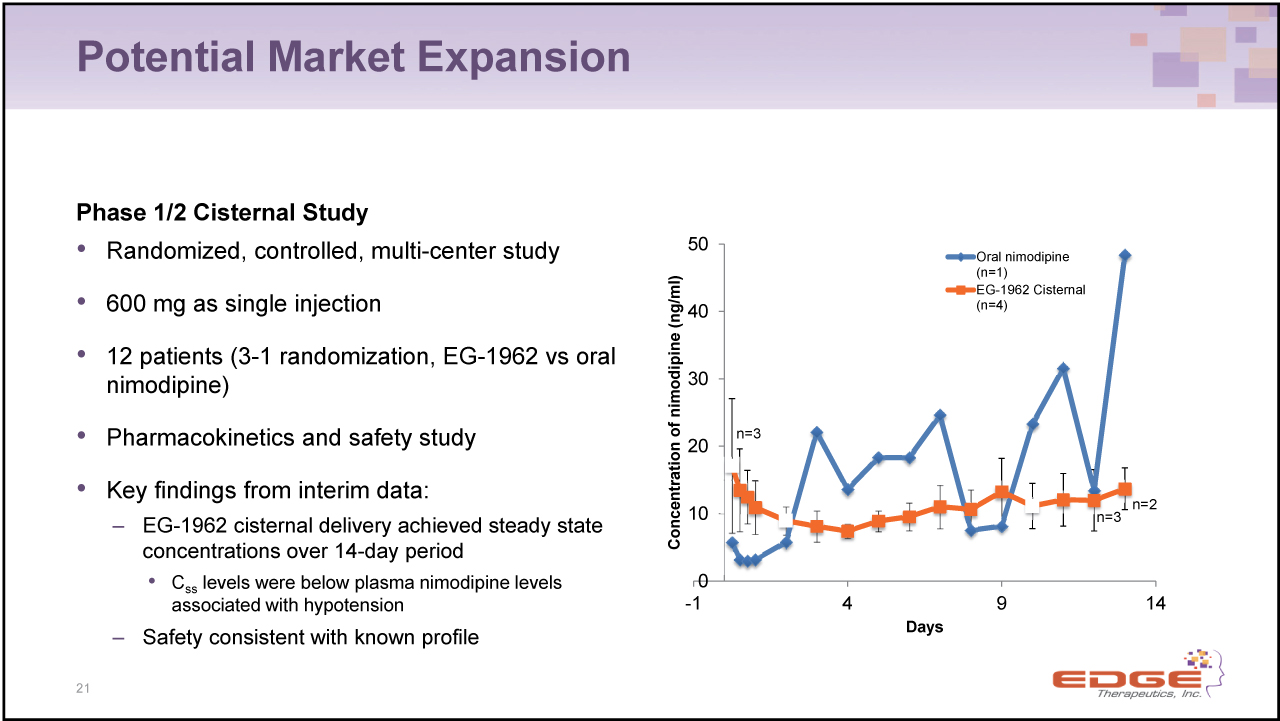
Potential Market Expansion Phase 1/2 Cisternal Study 21 Randomized, controlled, multi-center study600 mg as single injection12 patients (3-1 randomization, EG-1962 vs oral nimodipine)Pharmacokinetics and safety studyKey findings from interim data:EG-1962 cisternal delivery achieved steady state concentrations over 14-day periodCss levels were below plasma nimodipine levels associated with hypotensionSafety consistent with known profile n=3
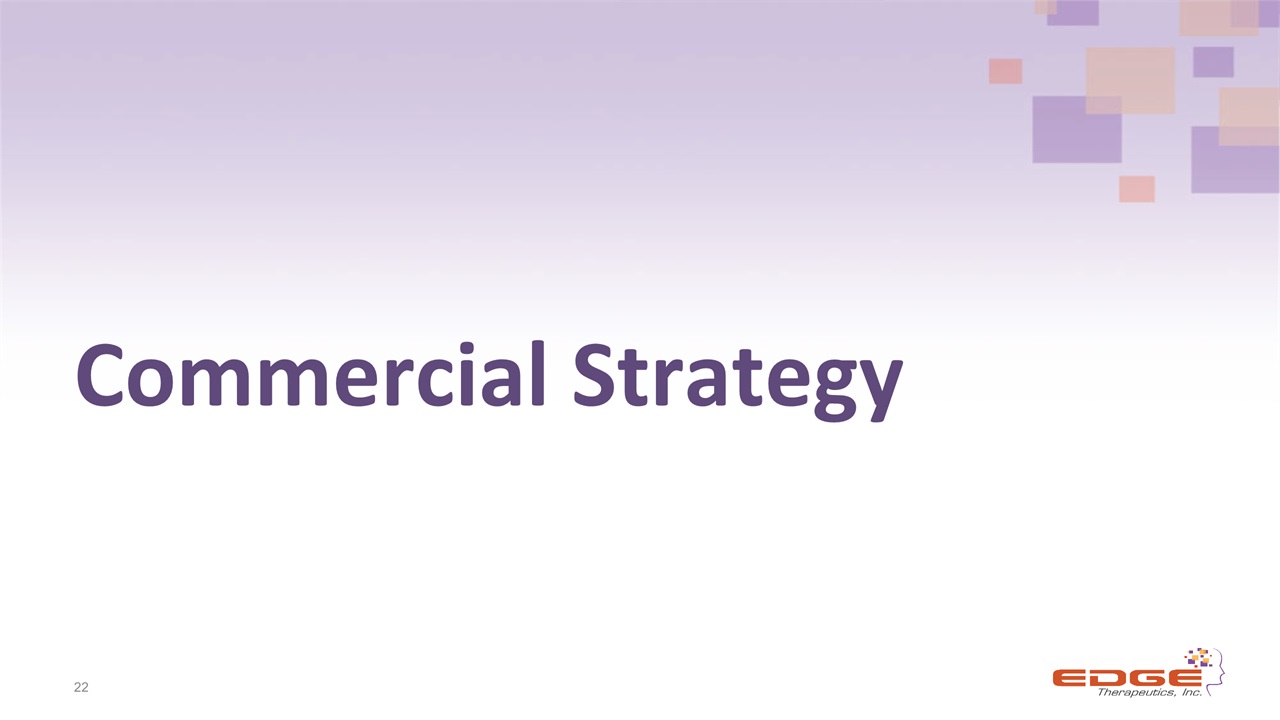
Commercial Strategy 22
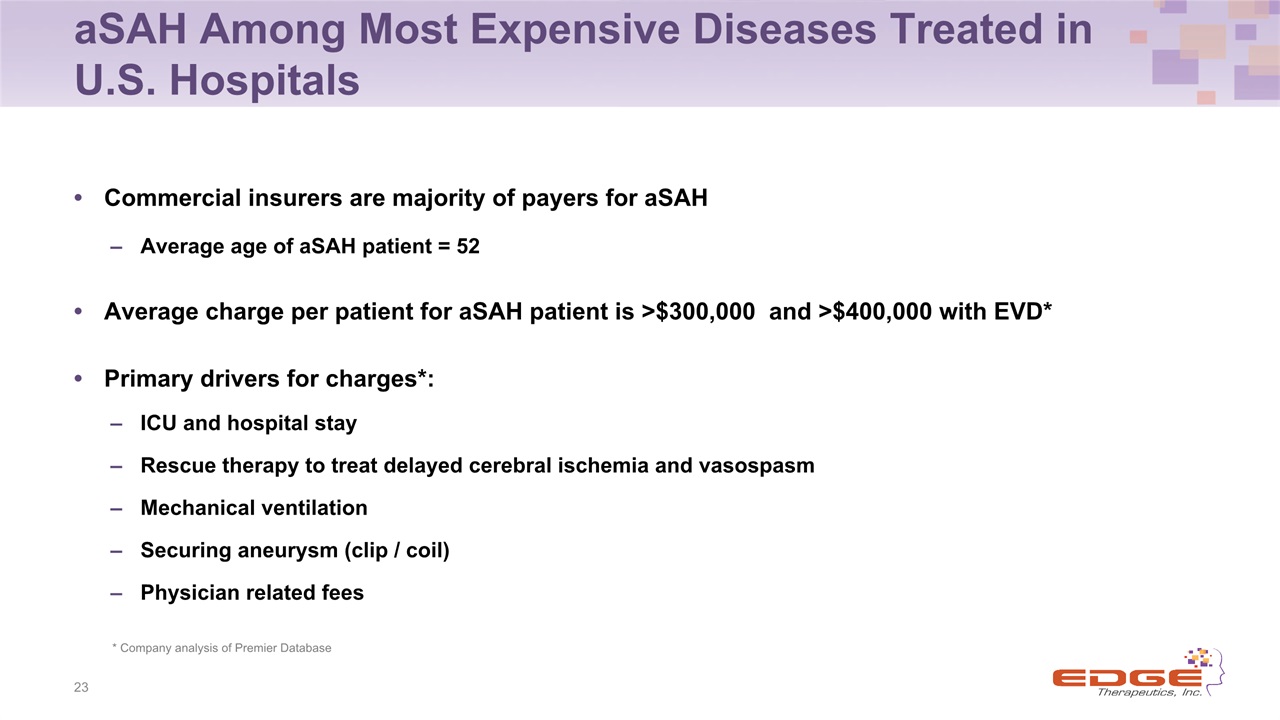
aSAH Among Most Expensive Diseases Treated in U.S. Hospitals Commercial insurers are majority of payers for aSAHAverage age of aSAH patient = 52Average charge per patient for aSAH patient is >$300,000 and >$400,000 with EVD*Primary drivers for charges*: ICU and hospital stayRescue therapy to treat delayed cerebral ischemia and vasospasmMechanical ventilationSecuring aneurysm (clip / coil)Physician related fees 23 * Company analysis of Premier Database

Commercial Strategy Strong relationships with key hospital decision makers 24 North America:Small, targeted sales force of ~35 representatives Europe:Similar-sized sales force to NA~100 hospitals account for 90% of all aSAH patients in five largest European markets ~300 hospitals accountfor 90% of all aSAH patients Drivers for rapid adoption: EG-1962 administration does not materially change current physician behavior / treatment protocol Pharmacoeconomic benefit: preventing DCI saves hospitals and managed care organizations substantial costs, plus outpatient rehab / nursing home costs

Three-Layered Approach to Maintain High Barrier-to-Entry 25 4 issued U.S. patents (including Composition of Matter), 12 issued foreign patents and more than 50 U.S. and foreign pending patent applications Intellectual Property Potentially difficult for competitors to prove bioequivalence (i.e., human trial required) Ability to prove bioequivalence 1. 2. 3. Manufacturing know-how & trade secrets PRECISA development platform

Controlled & Sustained Release The Future: PRECISA™ Development Platform 26 Proprietary, programmable, biodegradable polymer-based development platform Optimize product Program release profileSpecific blend of polymers Initial release profileSustained release profile Define product profileIdentify therapeuticEngineer polymerPhysical / chemical properties Identify unmetclinical condition Targeted Delivery

EG-1962 Summary Pharmacokinetic rationaleImproved outcomes vs nimodipine without off-target side effects in Phase 2 study; supports premium pricing rationaleDe-risked path to marketPivotal phase 3 design replicates key elements of phase 2 protocol505(b)(2) regulatory pathway allows for reduced development burdenHigh Barriers to EntryOrphan designation – potentially eligible for 7 years of marketing exclusivityComposition of matter patent to 2033 27

Recent and Expected Key Milestones 28 1H’17 2H’17 1H’18 Received pediatric waiver from EMA for EG-1962 Initiated study of EG-1962 cisternal delivery Secured $18M from RDO EG-1962 cisternal PK data update Entered into commercial supply agreement for EG-1962 Initiated EG-1962 lumbar PK animal study NEWTON 2 futility analysis by end-2017 EG-1962 health economic data NEWTON 2 interim analysis in early-2018 – On Track 2H’18 NEWTON 2 full top-line data in late-2018 Submit IND for second PRECISA product in 2018 P P P P P P P P

EDGE Therapeutics 29
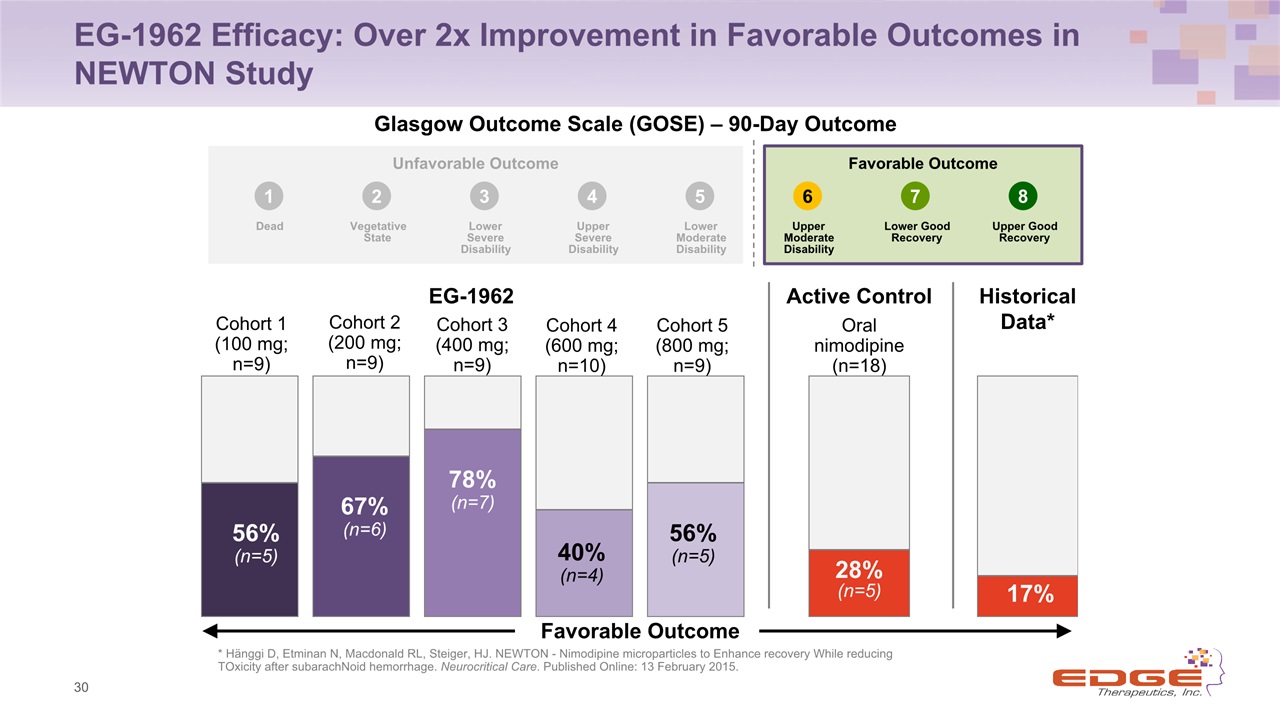
Dead Vegetative State Lower Severe Disability Upper Severe Disability Lower Moderate Disability 1 2 3 4 5 Unfavorable Outcome 56% (n=5) 78% (n=7) 67% (n=6) 40% (n=4) 56% (n=5) Cohort 1 (100 mg; n=9) Oral nimodipine(n=18) Cohort 2(200 mg; n=9) Cohort 3(400 mg;n=9) Cohort 4(600 mg; n=10) Cohort 5(800 mg; n=9) EG-1962 Efficacy: Over 2x Improvement in Favorable Outcomes in NEWTON Study 30 Glasgow Outcome Scale (GOSE) – 90-Day Outcome Upper Moderate Disability Lower Good Recovery Upper Good Recovery 6 7 8 Favorable Outcome EG-1962 Active Control (n=5) 28% HistoricalData* 17% Favorable Outcome * Hänggi D, Etminan N, Macdonald RL, Steiger, HJ. NEWTON - Nimodipine microparticles to Enhance recovery While reducing TOxicity after subarachNoid hemorrhage. Neurocritical Care. Published Online: 13 February 2015.
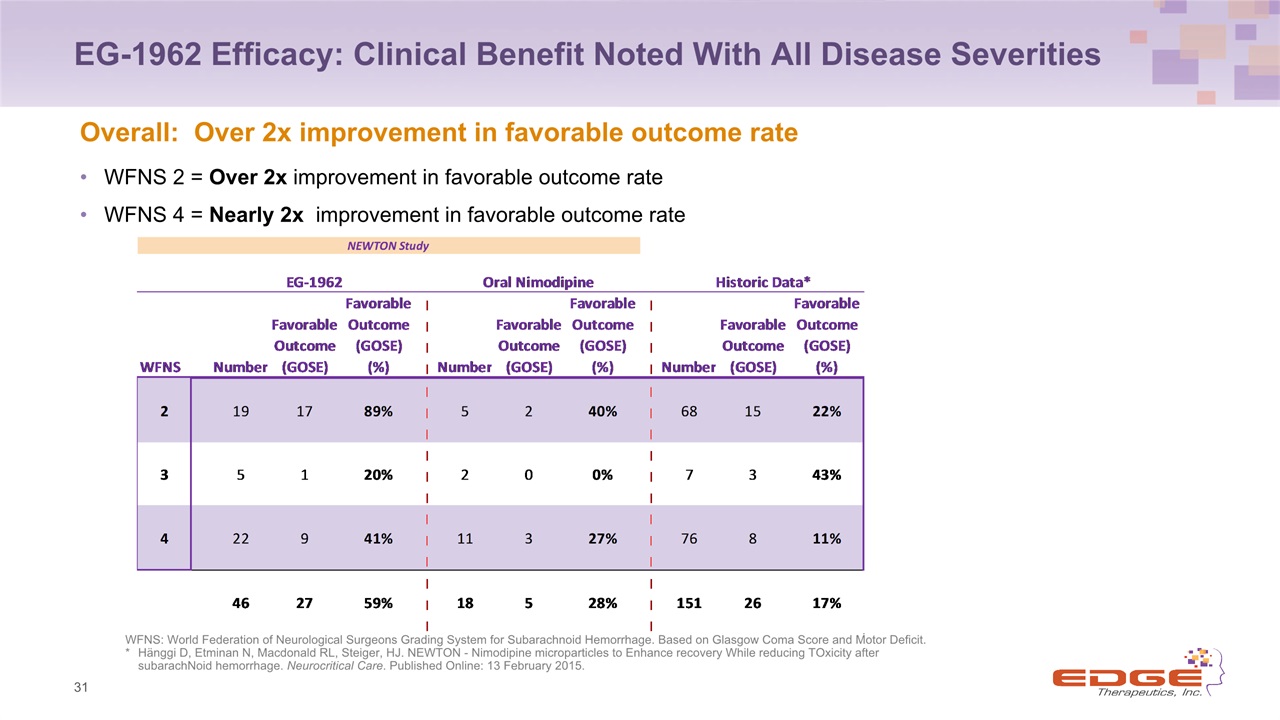
EG-1962 Efficacy: Clinical Benefit Noted With All Disease Severities 31 WFNS 2 = Over 2x improvement in favorable outcome rateWFNS 4 = Nearly 2x improvement in favorable outcome rate Overall: Over 2x improvement in favorable outcome rate WFNS: World Federation of Neurological Surgeons Grading System for Subarachnoid Hemorrhage. Based on Glasgow Coma Score and Motor Deficit.* Hänggi D, Etminan N, Macdonald RL, Steiger, HJ. NEWTON - Nimodipine microparticles to Enhance recovery While reducing TOxicity after subarachNoid hemorrhage. Neurocritical Care. Published Online: 13 February 2015.

EG-1964 for cSDH Aprotinin: pancreatic trypsin inhibitor FDA approved in 1993 to prevent rebleeding following cardiac bypass surgeryMechanism of action potentially effective in reducing the incidence of rebleeding in cSDH patients 32 EG-1964 is a polymer-based therapeutic containing aprotinin for the management of cSDH as a prophylactic treatment to prevent recurrent bleeding If approved, we believe EG-1964 could address a significant unmet medical need and become the standard of care for treatment of cSDH in patients (2)
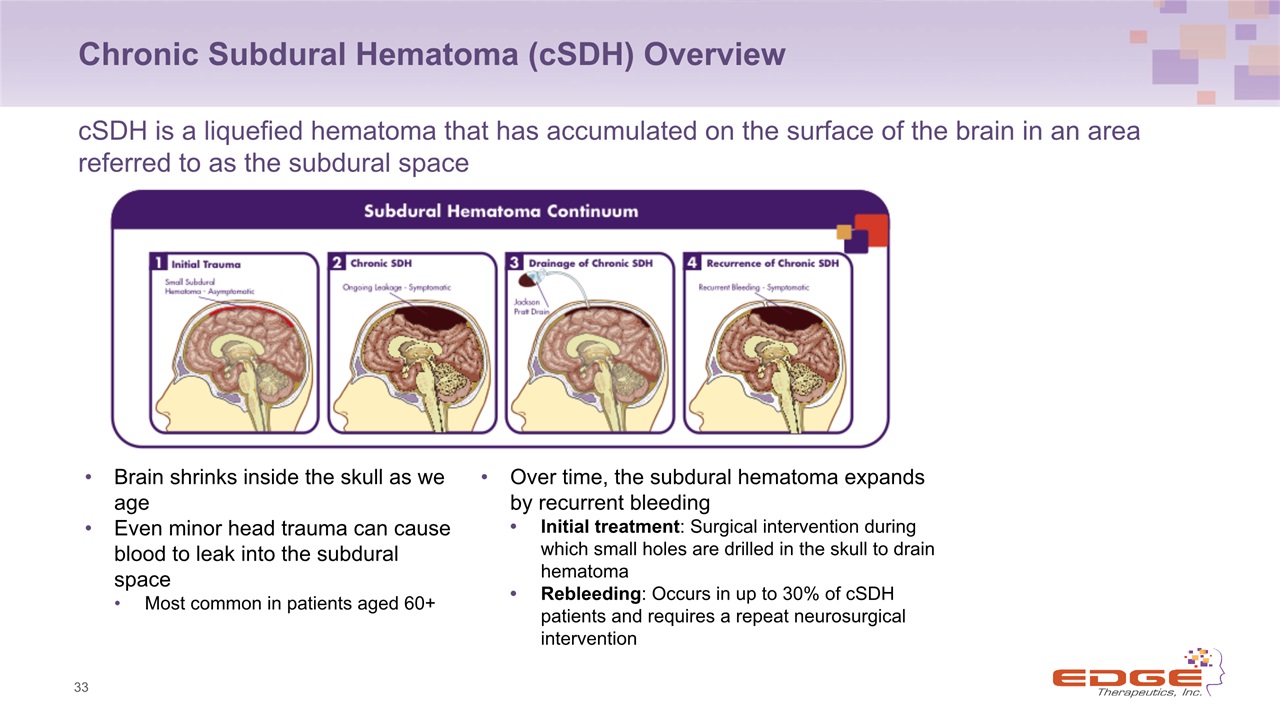
Chronic Subdural Hematoma (cSDH) Overview 33 cSDH is a liquefied hematoma that has accumulated on the surface of the brain in an area referred to as the subdural space Brain shrinks inside the skull as we ageEven minor head trauma can cause blood to leak into the subdural spaceMost common in patients aged 60+ Over time, the subdural hematoma expands by recurrent bleedingInitial treatment: Surgical intervention during which small holes are drilled in the skull to drain hematomaRebleeding: Occurs in up to 30% of cSDH patients and requires a repeat neurosurgical intervention
